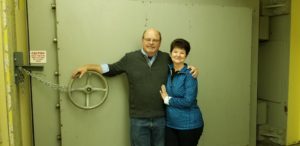Autumn is conference season. Bouchercon morphed into C3 (Creatures, Crimes & Creativity con), which then morphed into Magna Cum Murder. As a former road warrior, traveling by air all the time, I decided this year to skip the airport this year and drive from Northern Virginia to Indianapolis for Magna. On the way out, we broke the trip into two, four-and-a-half-hour drives, stopping for a night in Wheeling, West Virginia. For the trip home, we decided to take the southern route, which took us through White Sulfur Springs, West Virginia, the home of the stately and wonderful Greenbrier Resort (and yes, that’s spelled properly).
From 1962 till 1992 The Greenbrier kept an important secret. Then a reporter from the Washington Post decided on his own that the world needed to know something that the government had classified Top Secret. The Greenbrier had been designated as the relocation spot for members of the US Senate and House of Representatives in the event of a nuclear attack. (I’m told that said reporter now teaches journalistic ethics at the collegiate level. Just sayin’.) A 112,000-square-foot, 153-room bunker facility lies buried 720 feet under the Allegheny Mountains, and is constructed of 50,000 tons of reinforced concrete. One of the four blast doors that provides access to the bunker weighs 25 tons, and swings on hinges that are four feet long, 14 inches wide and eight inches thick.
The bunker was built in total secret. How, you might ask? That’s where storytellers became important. Beginning in 1955, the C&O Railroad, owner of the resort at the time, started a press campaign celebrating an expansion of the hotel which would add the West Virginia Wing, featuring new guest rooms and massive exhibition space for business meetings and trade shows.
And here’s the thing: When the bunker was finished in 1962, the massive spaces were all used for business meetings and trade shows. One of the nation’s most important secrets was kept in plain sight! The enormous blast doors were disguised as walls, and the House and Senate chambers were rented out for classes and business meetings. Who would think to ask if the walls were five feet thick?
For thirty years, the bunker was maintained by a crew of thirteen very special workers who doubled as the television and electronics maintenance team for the hotel and its visitors. Their cover worked because they actually were the television and maintenance team for The Greenbrier.
If the balloon ever went up, the U.S. Government Relocation Facility–the official name for the bunker–would have become home to roughly 1,100 members of congress and their staffs. Sleeping in bunks and sharing bathrooms and showers, conditions would have been Spartan at best. Even in the early sixties, the folks who ran the bunker understood that cramming passionate politicians from all persuasions into tight quarters could lead to flashes of temper. They understood that after weeks of living underground, somebody might go a little nuts and try to open the blast doors to expose everyone to fallout. Thus, there was a safe, accessible only to security personnel, where riot gear was stored. Because these people needed to be fed in shifts and it was therefore necessary to move people along, the architects intentionally included design features that made the cafeteria an unpleasant place to sit and talk.
One of the planning details that impressed me the most was the White House backdrop on the wall of the media room. The president and the executive branch would never have come near The Greenbrier, so it made sense that the Capitol Building backdrop would be part of any broadcast, but why the White House backdrop? Well, if the president and vice president were killed, the speaker of the House of Representatives would become the president, and they were prepared for that eventuality.
And then there was the incinerator room. Yes, it burned documents and clothing that were brought in, but the designers had also taken into consideration that members of congress were of a certain age, and that there would be lots of stress, and, well, you know. Burial really wasn’t possible.
As I took this tour, my mind whirled at about a million rpm. Think classic locked-room mystery. Think psychological thriller. Think political thriller. Is there any place one couldn’t go with that kind of setup?



I’d heard of this somewhere, but thanks for the reminder and all the details. Story fodder for sure.
Sounds like a fascinating place, John. Thanks for sharing. Great pic, btw!
The ultimate coup. The President and his cronies plant the progressively threatening news stories. Congress is moved to the bunker. The doors close. Ooops, no bombs. Now no congress only an executive branch.
POV 1, what does now Executive for Life do to remake America to his liking?
POV 2, junior congressional aid thinks they have been faked into the bunker. Can he/she restore democracy?
I just finished _The Handmaid’s Tale_, where the State of Gilead got its start when some armed group stormed the Capitol and killed the entire Congress.
Zombie apocalypse bunker, that’s where my mind went.
This sounds like it would make a perfect audiobook recording booth!
Wow. That is really cool. It would make a great setting.
Do you think we could lock up the current congress here??? 😉
It’s a good thing I’m not the kind of person to get involved in politics. If I had ever risen high enough in the power side of politics and had had to go there for safety, I would have started the rumor that, actually, this place is a prison and we’re all going to be executed.
After the crisis was all over and we were released, I would have typed up my notes regarding the experience and sent the manuscript to my publisher.